JAGUAR XJ 2004 X350 / 3.G Workshop Manual
Manufacturer: JAGUAR, Model Year: 2004, Model line: XJ, Model: JAGUAR XJ 2004 X350 / 3.GPages: 227, PDF Size: 4.22 MB
Page 51 of 227
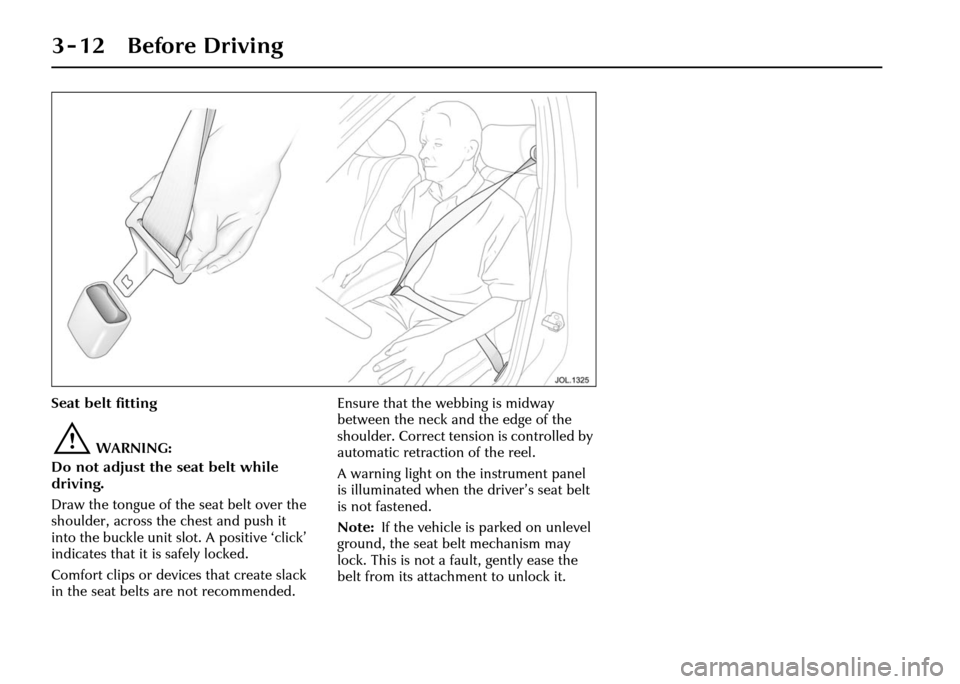
3 - 12 Before Driving
Seat belt fitting
!WARNING:
Do not adjust the seat belt while
driving.
Draw the tongue of the seat belt over the
shoulder, across the chest and push it
into the buckle unit slot. A positive ‘click’
indicates that it is safely locked.
Comfort clips or devices that create slack
in the seat belts are not recommended. Ensure that the webbing is midway
between the neck and the edge of the
shoulder. Correct tension is controlled by
automatic retraction of the reel.
A warning light on the instrument panel
is illuminated when the driver’s seat belt
is not fastened.
Note:
If the vehicle is parked on unlevel
ground, the seat belt mechanism may
lock. This is not a fault, gently ease the
belt from its attachment to unlock it.
Page 52 of 227

Before Driving 3 - 13
Inertia reel mechanism check
Static test: Whilst seated, fasten the seat
belt and grip the shoulder belt at
approximately shoulder level with the
opposite hand. Pull the belt sharply
downwards, the belt should lock.
Road test: The following road test must
be carried out only under maximum safe
road conditions.
With the seat belt correctly fitted to the
driver and passenger(s), drive the vehicle
at 5 mph (8 km/h) and, ensuring that it is
safe to do so, brake sharply.
The seat belt(s) should lock automatically,
holding both driver and passenger(s)
securely in position.
It is important when braking that the
reactions of both driver and passenger(s)
are normal, that is, the body must not be
thrown forward in anticipation, thus
causing a snatching action of the belt
which would operate the locking
mechanism.
If the belt fails to lock on either test,
consult a Jaguar Retailer.
!WARNING:
1. Seat belts are designed to bear upon the bony structure of the
body. The lap section of the belt
must be worn low across the front
of the pelvis and NOT across the
abdominal area. Always ensure
that the webbing is midway
between the neck and the edge of
the shoulder.
2. Care should be taken to avoid contamination of the webbing
with polishes, oils and chemicals,
and particularly battery acid.
Cleaning may safely be carried out
using mild soap and water.
If webbing becomes frayed,
contaminated or damaged,
discard it and fit a new seat belt.
3. It is essential to renew the entire assembly after it has been worn in
a severe impact even if damage to
the assembly is not obvious. 4. Belts should not be worn with the
webbing twisted.
5. Each seat belt assembly must only be used by one occupant; it is
dangerous to put a seat belt
around a child being carried on
the occupant’s lap.
6. No modifications or additions s h o u l d b e m a d e b y t h e u s e r w h i c h
will prevent the seat belt adjusting
devices from operating.
7. Should the seat belt not retract and remain at its static length,
consult your nearest Jaguar
Retailer immediately.
Page 53 of 227
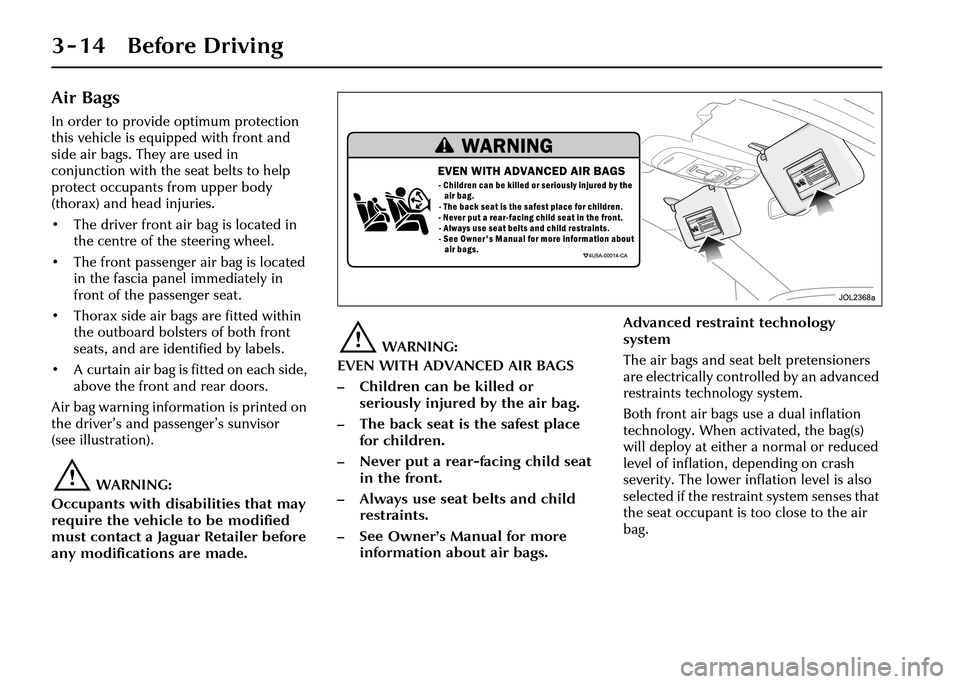
3 - 14 Before Driving
Air Bags
In order to provide optimum protection
this vehicle is equipped with front and
side air bags. They are used in
conjunction with the seat belts to help
protect occupants from upper body
(thorax) and head injuries.
• The driver front air bag is located in
the centre of the steering wheel.
• The front passenger air bag is located in the fascia pane l immediately in
front of the passenger seat.
• Thorax side air bags are fitted within the outboard bolsters of both front
seats, and are identified by labels.
• A curtain air bag is fitted on each side, above the front and rear doors.
Air bag warning information is printed on
the driver’s and passenger’s sunvisor
(see illustration).
!WARNING:
Occupants with disabilities that may
require the vehicle to be modified
must contact a Jaguar Retailer before
any modifications are made.
!WARNING:
EVEN WITH ADVANCED AIR BAGS
– Children can be killed or seriously injured by the air bag.
– The back seat is the safest place for children.
– Never put a rear-facing child seat in the front.
– Always use seat belts and child restraints.
– See Owner’s Manual for more information about air bags. Advanced restra
int technology
system
The air bags and seat belt pretensioners
are electrically controlled by an advanced
restraints technology system.
Both front air bags use a dual inflation
technology. When activated, the bag(s)
will deploy at either a normal or reduced
level of inflation, depending on crash
severity. The lower inflation level is also
selected if the restraint system senses that
the seat occupant is too close to the air
bag.
Page 54 of 227
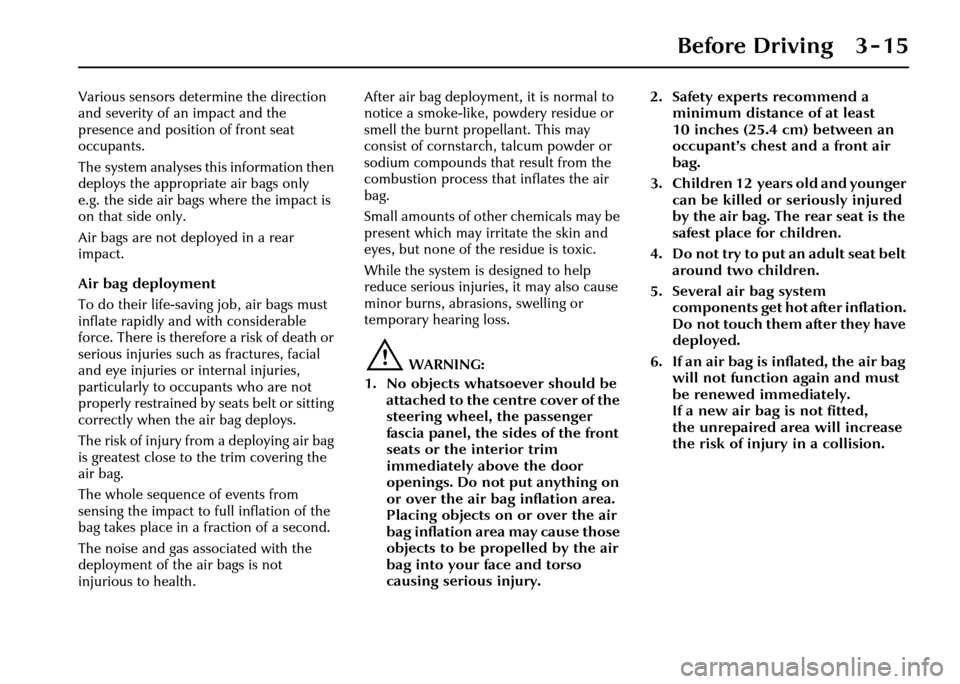
Before Driving 3 - 15
Various sensors determine the direction
and severity of an impact and the
presence and position of front seat
occupants.
The system analyses this information then
deploys the appropriate air bags only
e.g. the side air bags where the impact is
on that side only.
Air bags are not deployed in a rear
impact.
Air bag deployment
To do their life-saving job, air bags must
inflate rapidly and with considerable
force. There is therefore a risk of death or
serious injuries such as fractures, facial
and eye injuries or internal injuries,
particularly to occupants who are not
properly restrained by seats belt or sitting
correctly when the air bag deploys.
The risk of injury fr om a deploying air bag
is greatest close to the trim covering the
air bag.
The whole sequence of events from
sensing the impact to full inflation of the
bag takes place in a fraction of a second.
The noise and gas associated with the
deployment of the air bags is not
injurious to health. After air bag deployme
nt, it is normal to
notice a smoke-like, powdery residue or
smell the burnt propellant. This may
consist of cornstarch, talcum powder or
sodium compounds that result from the
combustion process that inflates the air
bag.
Small amounts of other chemicals may be
present which may irri tate the skin and
eyes, but none of the residue is toxic.
While the system is designed to help
reduce serious injuries, it may also cause
minor burns, abrasions, swelling or
temporary hearing loss.
!WARNING:
1. No objects whatso ever should be
attached to the centre cover of the
steering wheel, the passenger
fascia panel, the sides of the front
seats or the interior trim
immediately above the door
openings. Do not put anything on
or over the air bag inflation area.
Placing objects on or over the air
bag inflation area may cause those
objects to be propelled by the air
bag into your face and torso
causing serious injury. 2. Safety experts recommend a
minimum distance of at least
10 inches (25.4 cm) between an
occupant’s chest and a front air
bag.
3. Children 12 years old and younger can be killed or seriously injured
by the air bag. The rear seat is the
safest place for children.
4. Do not try to put an adult seat belt around two children.
5. Several air bag system components get hot after inflation.
Do not touch them after they have
deployed.
6. If an air bag is inflated, the air bag will not function again and must
be renewed immediately.
If a new air bag is not fitted,
the unrepaired area will increase
the risk of injury in a collision.
Page 55 of 227
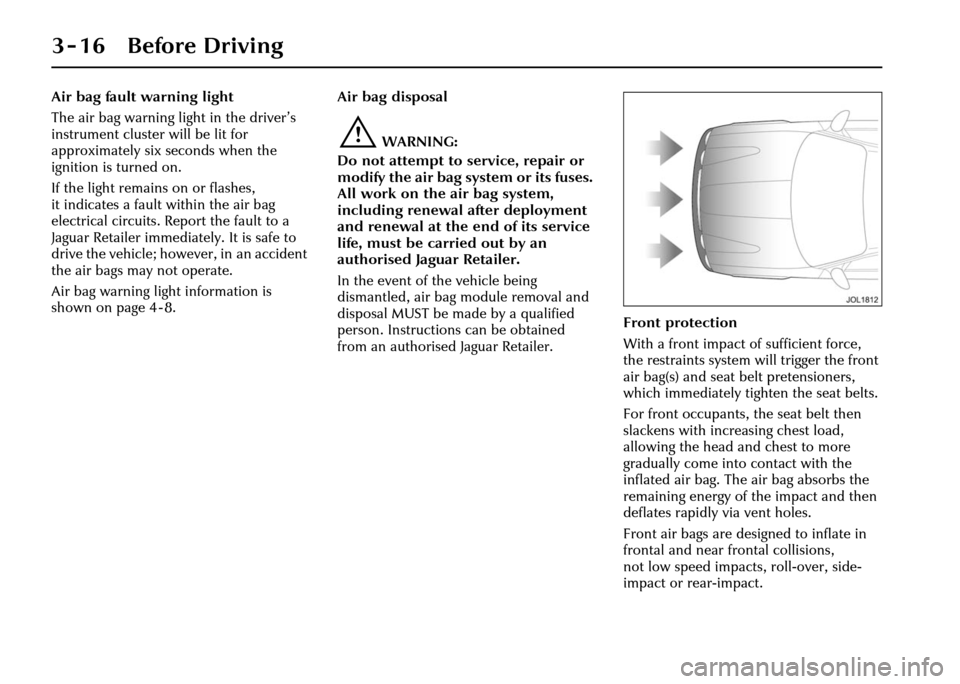
3 - 16 Before Driving
Air bag fault warning light
The air bag warning light in the driver’s
instrument cluster will be lit for
approximately six seconds when the
ignition is turned on.
If the light remains on or flashes,
it indicates a fault within the air bag
electrical circuits. Report the fault to a
Jaguar Retailer immediately. It is safe to
drive the vehicle; however, in an accident
the air bags may not operate.
Air bag warning ligh t information is
shown on page 4 - 8. Air bag disposal
!WARNING:
Do not attempt to service, repair or
modify the air bag sy stem or its fuses.
All work on the air bag system,
including renewal after deployment
and renewal at the end of its service
life, must be carried out by an
authorised Jaguar Retailer.
In the event of the vehicle being
dismantled, air bag module removal and
disposal MUST be made by a qualified
person. Instructions can be obtained
from an authorised Jaguar Retailer. Front protection
With a front impact of sufficient force,
the restraints system will trigger the front
air bag(s) and seat belt pretensioners,
which immediately tighten the seat belts.
For front occupants, the seat belt then
slackens with increasing chest load,
allowing the head and chest to more
gradually come into contact with the
inflated air bag. The air bag absorbs the
remaining energy of the impact and then
deflates rapidly via vent holes.
Front air bags are designed to inflate in
frontal and near fr
ontal collisions,
not low speed impacts, roll-over, side-
impact or rear-impact.
Page 56 of 227
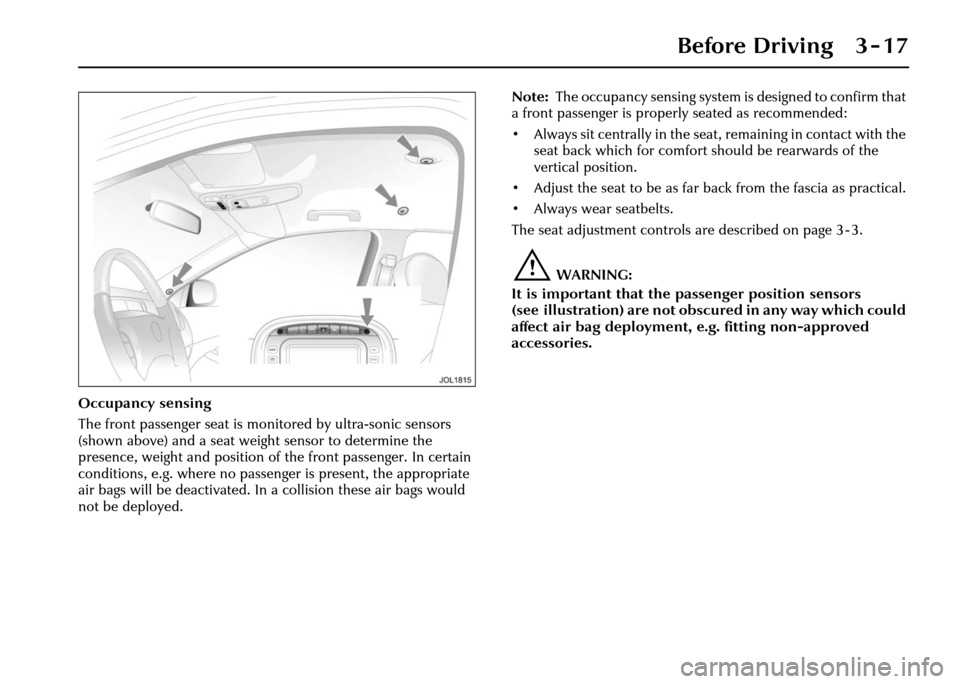
Before Driving 3 - 17
Occupancy sensing
The front passenger seat is monitored by ultra-sonic sensors
(shown above) and a seat weight sensor to determine the
presence, weight and position of the front passenger. In certain
conditions, e.g. where no passenger is present, the appropriate
air bags will be deactivated. In a collision these air bags would
not be deployed. Note:
The occupancy sensing system is designed to confirm that
a front passenger is properly seated as recommended:
• Always sit centrally in the seat, remaining in contact with the seat back which for comfort should be rearwards of the
vertical position.
• Adjust the seat to be as far back from the fascia as practical.
• Always wear seatbelts.
The seat adjustment controls are described on page 3 - 3.
!WARNING:
It is important that the passenger position sensors
(see illustration) are not obscured in any way which could
affect air bag deployment, e.g. fitting non-approved
accessories.
Page 57 of 227
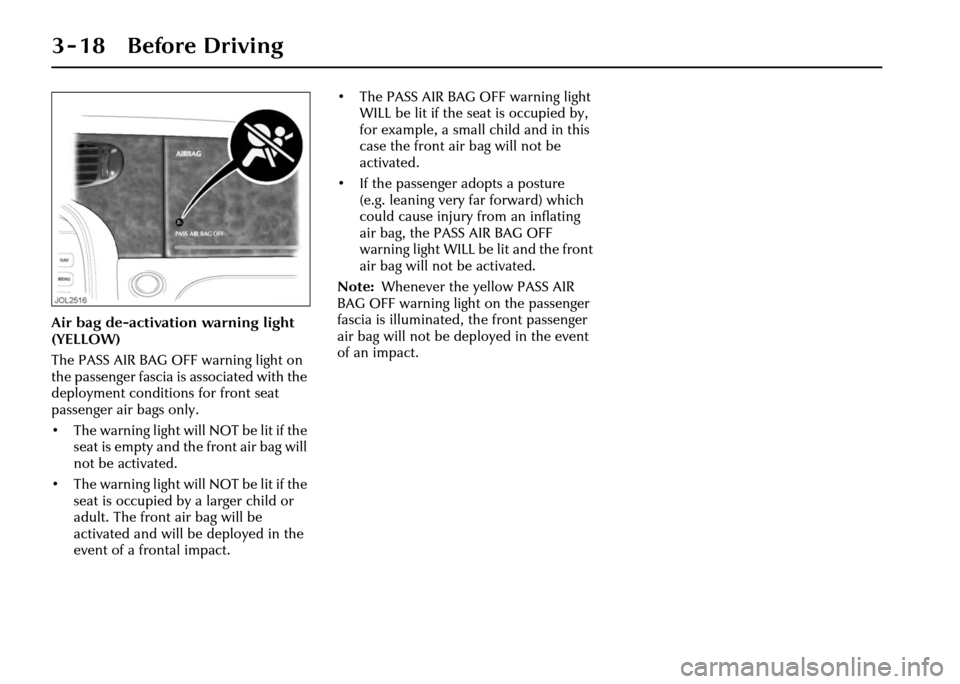
3 - 18 Before Driving
Air bag de-activation warning light
(YELLOW)
The PASS AIR BAG OFF warning light on
the passenger fascia is associated with the
deployment conditions for front seat
passenger air bags only.
• The warning light will NOT be lit if the seat is empty and the front air bag will
not be activated.
• The warning light will NOT be lit if the seat is occupied by a larger child or
adult. The front air bag will be
activated and will be deployed in the
event of a frontal impact. • The PASS AIR BAG OFF warning light
WILL be lit if the seat is occupied by,
for example, a small child and in this
case the front air bag will not be
activated.
• If the passenger adopts a posture (e.g. leaning very far forward) which
could cause injury from an inflating
air bag, the PASS AIR BAG OFF
warning light WILL be lit and the front
air bag will not be activated.
Note: Whenever the yellow PASS AIR
BAG OFF warning light on the passenger
fascia is illuminated, the front passenger
air bag will not be deployed in the event
of an impact.
Page 58 of 227
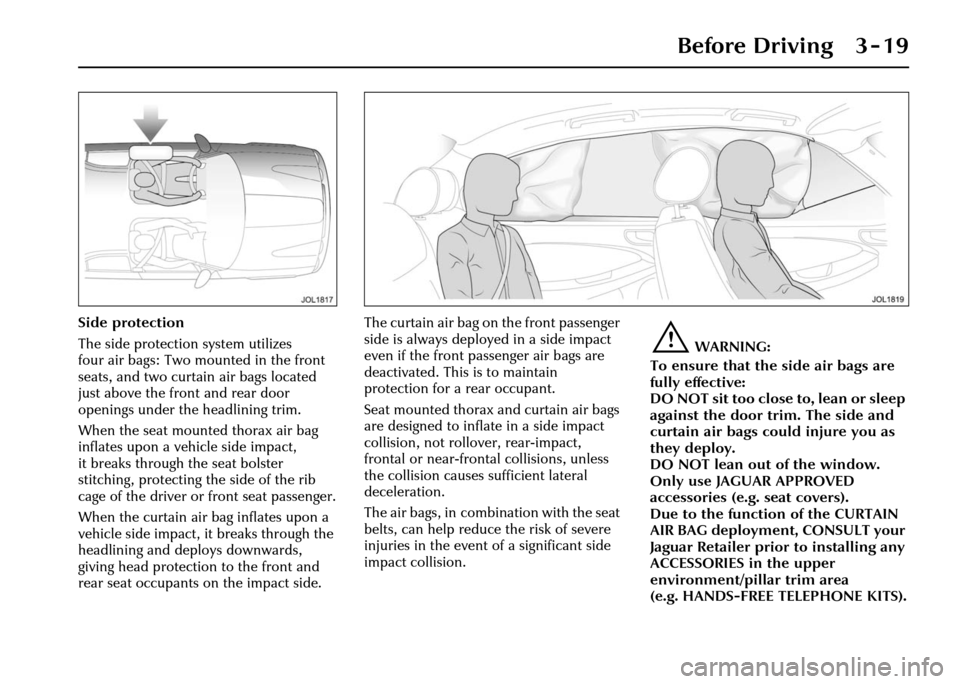
Before Driving 3 - 19
Side protection
The side protection system utilizes
four air bags: Two mounted in the front
seats, and two curtain air bags located
just above the front and rear door
openings under the headlining trim.
When the seat mounted thorax air bag
inflates upon a vehicle side impact,
it breaks through the seat bolster
stitching, protecting the side of the rib
cage of the driver or front seat passenger.
When the curtain air bag inflates upon a
vehicle side impact, it breaks through the
headlining and de ploys downwards,
giving head protection to the front and
rear seat occupants on the impact side. The curtain air bag on the front passenger
side is always deployed in a side impact
even if the front passenger air bags are
deactivated. This is to maintain
protection for a
rear occupant.
Seat mounted thorax and curtain air bags
are designed to inflate in a side impact
collision, not rollover, rear-impact,
frontal or near-frontal collisions, unless
the collision causes sufficient lateral
deceleration.
The air bags, in combin ation with the seat
belts, can help reduce the risk of severe
injuries in the event of a significant side
impact collision.
!WARNING:
To ensure that the side air bags are
fully effective:
DO NOT sit too close to, lean or sleep
against the door trim. The side and
curtain air bags could injure you as
they deploy.
DO NOT lean out of the window.
Only use JAGUAR APPROVED
accessories (e.g. seat covers).
Due to the function of the CURTAIN
AIR BAG deployment, CONSULT your
Jaguar Retailer prior to installing any
ACCESSORIES in the upper
environment/pillar trim area
(e.g. HANDS-FREE TELEPHONE KITS).
Page 59 of 227
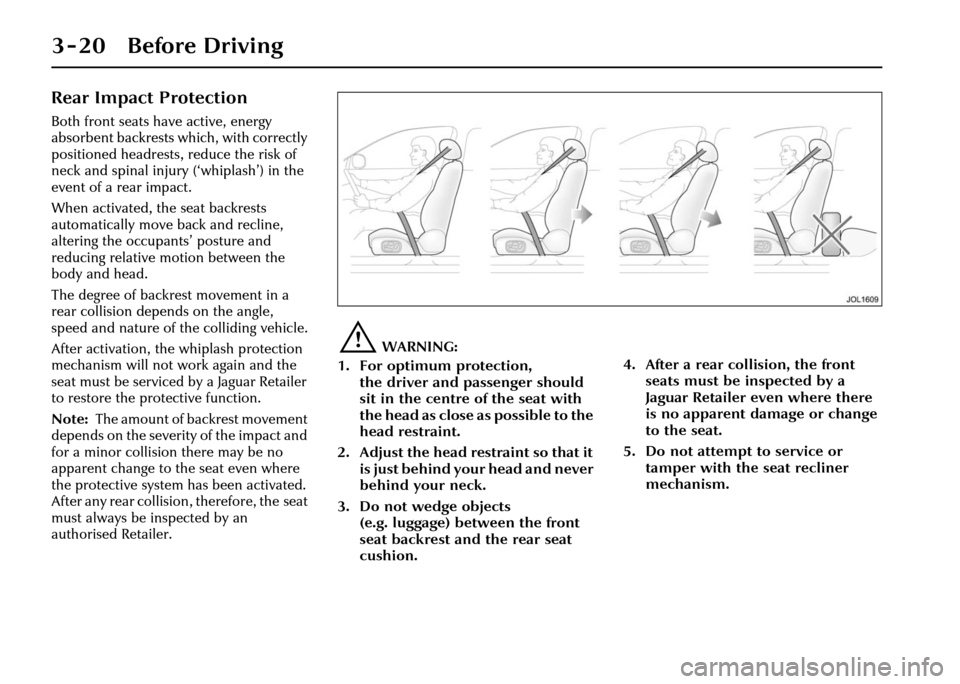
3 - 20 Before Driving
Rear Impact Protection
Both front seats have active, energy
absorbent backrests which, with correctly
positioned headrests, reduce the risk of
neck and spinal injury (‘whiplash’) in the
event of a rear impact.
When activated, the seat backrests
automatically move back and recline,
altering the occupants’ posture and
reducing relative motion between the
body and head.
The degree of backrest movement in a
rear collision depends on the angle,
speed and nature of the colliding vehicle.
After activation, the w hiplash protection
mechanism will not work again and the
seat must be serviced by a Jaguar Retailer
to restore the protective function.
Note: The amount of backrest movement
depends on the severity of the impact and
for a minor collision there may be no
apparent change to the seat even where
the protective system has been activated.
After any rear collisio n, therefore, the seat
must always be inspected by an
authorised Retailer.
!WARNING:
1. For optimum protection, the driver and passenger should
sit in the centre of the seat with
the head as close as possible to the
head restraint.
2. Adjust the head re straint so that it
is just behind your head and never
behind your neck.
3. Do not wedge objects (e.g. luggage) between the front
seat backrest and the rear seat
cushion. 4. After a rear collision, the front
seats must be inspected by a
Jaguar Retailer even where there
is no apparent da mage or change
to the seat.
5. Do not attempt to service or tamper with the seat recliner
mechanism.
Page 60 of 227
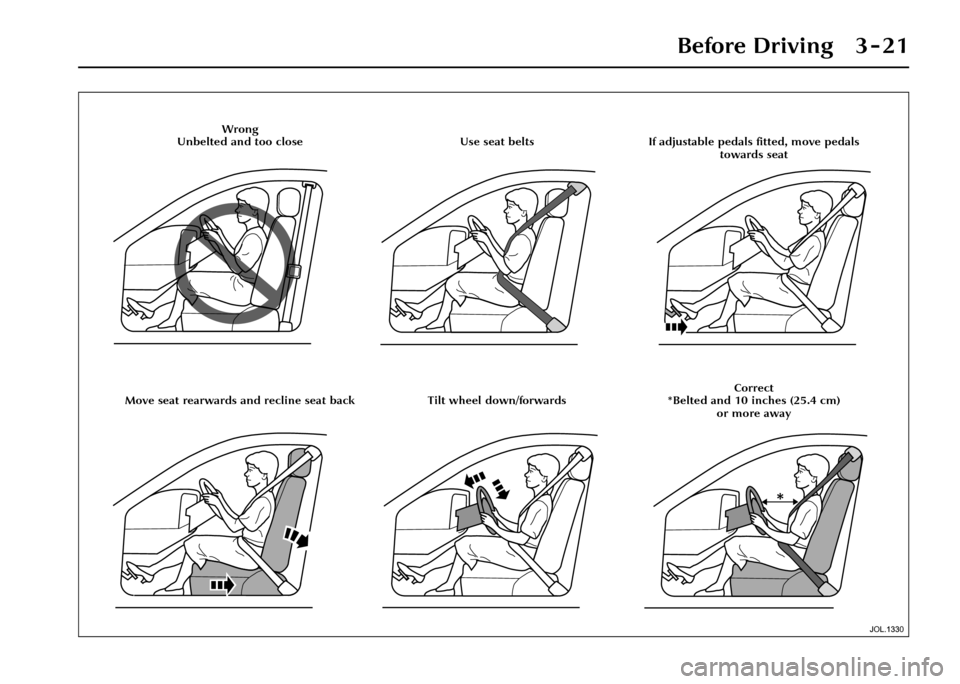
Before Driving 3 - 21
Wrong
Unbelted and too close Use seat belts If adjustable pedals fitted, move pedals towards seat
Move seat rearwards and recline seat back Tilt wheel down/forwards Correct
*Belted and 10 inches (25.4 cm) or more away